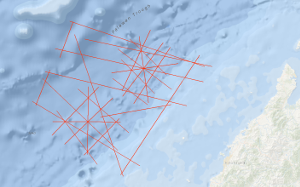The main objectives of the BGR cruise BGR01 POPSCOMS (Properties of a Gas Hydrate Province on a Subduction-Collision Related Margin off Sabah) off Sabah/Malaysia with M/V AKADEMIK NEMCHINOV from 4th November to 3rd December 2001 in co-operation with PETRONAS Malaysia are the research on (1) Marine Methane Gas Hydrates: Detection, distribution and formation; relation to the adjacent highly productive "conventional" gas province in the specific tectonic setting of the collisional belt off Sabah. (2) Tectonic development of the (accretionary) margin off Sabah: Improve the tectonic stratigraphic hypothesis of the subducted Proto-South-China-Sea and continental crust under the accretionary wedge, respectively in the subducted plate. Open questions and targets of the survey: Within the help of the already existing magnetic data and other seismic measurement methods (e.g. special refraction seismic with ocean-bottom hydrophones [OBH], which presumably is an exellent and adequate method) we try to discern between oceanic and continental crust in the subducted plate, to investigate the nature of the transition and get information on the subduction angle. This is important in relation to the Cagayan Ridge (Sulu Sea) that is interpreted as an island arc that is related to the subduction of the proto-South China Sea. Another aim was to enable the determination of seismic anisotropy, distribution of BSR's and hydrates in the area and their v(p) to v(s) ratios. Are the gas hydrates related to the adjacent highly productive "conventional" gas province? What is the structural character of the transition zone between the hydrate province and the adjacent conventional gas bearing province further up-slope? Conversely, are there indication for a possible deepwater source? Can initial conclusions be drawn regarding their biogenic or thermogenic origin? Is there an impact of sedimentation conditions, compressional behaviour (e.g. at active margins) and/or structural properties on the genesis and stability of gas hydrates and BSRs (Bottom Simulating Reflectors)? How do the findings under different conditions compare in that regard? Which are the favorable conditions for the genesis of gas hydrates, and can they be detected by geophysical methods even if there are no BSR's? The findings are expected to provide a contribution to the assessment of the deepwater hydrocarbon potential along the continental margin off Sabah. Results: In the study area the BSRs were identified on the base of their polarity reversal with respect to the seafloor and when they transect reflectors from the strata. The widely distributed BSRs along the seismic lines of the survey deliver an indirect indicator for the presence of gas hydrates in the study area (BSR's in post Miocene sediments). The BSR depths below seafloor vary between 250 and 350 m. Differences in the reflection coefficient of the BSRs are mainly related to the amount of free gas beneath the Gas Hydrate Stability Zone. Hauptziele der Fahrt BGR01 POPSCOMS (Properties of a Gas Hydrate Province on a Subduction-Collision Related Margin off Sabah) vor Sabah/Malaysia mit der M/S AKADEMIK NEMCHINOV vom 4. November bis zum 3. Dezember 2001 in Kooperation mit PETRONAS Malaysia sind die Erforschung von (1) Marinen Gashydraten: Entdeckung, Verteilung und Bildung sowie deren Beziehung zu den benachbarten hochproduktiven "konventionellen" Gasvorkommen in der speziellen tektonischen Situation des Kollisionsbereichs vor Sabah, (2) Tektonische Entwicklung des Akkretionsrandes vor Sabah: Unterstützung der bisherigen Vermutungen über die Tektonik und Stratigraphie des subduzierten frühzeitlichen Südchinesischen Meeres und der kontinentalen Kruste unter dem Akkretionskeil und insbesondere in der subduzierten Platte durch weitere Messungen. Offene Fragen und Ziele der Fahrt: Mithilfe von vorhandenen Magnetfelddaten und zusätzlichen seismischen Messungen (z.B. Refraktionsseismik mit am Meeresboden verankerten OBH (ocean bottom hydrophone) Systemen) soll die ozeanische von der kontinentalen Kruste in der subduzierten Platte unterschieden werden und der Subduktionsvorgang sowie der Subduktionswinkel ermittelt werden. Da der Cagayan-Rücken in der Sulu-See als Inselbogen interpretiert wird, der von der Subduktion des frühen Südchinesischen Meeres hervorgerufen wurde, ist ein Vergleich der beiden Gebiete von wissenschaftlichem Interesse. Ein weiteres Ziel der Fahrt ist die Ermittlung der seismischen Anisotropie, der Verteilung von BSRs (bottom simulating reflectors), die das Vorkommen von Gashydraten in diesem Gebiet anzeigen sowie das Verhältnis von Kompressions- zu Scherwellengeschwindigkeiten. Folgende Resultate konnten aus den Messungen ermittelt werden: Im Untersuchungsgebiet wurden die BSRs anhand deren Polaritätsumkehr im Vergleich zum Meeresboden identifiziert sowie durch das Durchkreuzen von sedimentären Reflektoren. Die in den Seismikprofilen vielfach erkennbaren BSRs liefern einen indirekten Hinweis auf das Vorkommen von Gashydraten im Untersuchungsgebiet in den Sedimenten, die zeitlich nach dem Miozän abgelagert wurden. Die Tiefen der BSRs unterhalb des Meeresbodens betragen zwischen 250 und 350 m. Unterschiede im Reflexionskoeffizienten der BSRs sind hauptsächlich auf den Anteil des freien Gases unterhalb der Gashydratstabilitätszone zurückzuführen.





